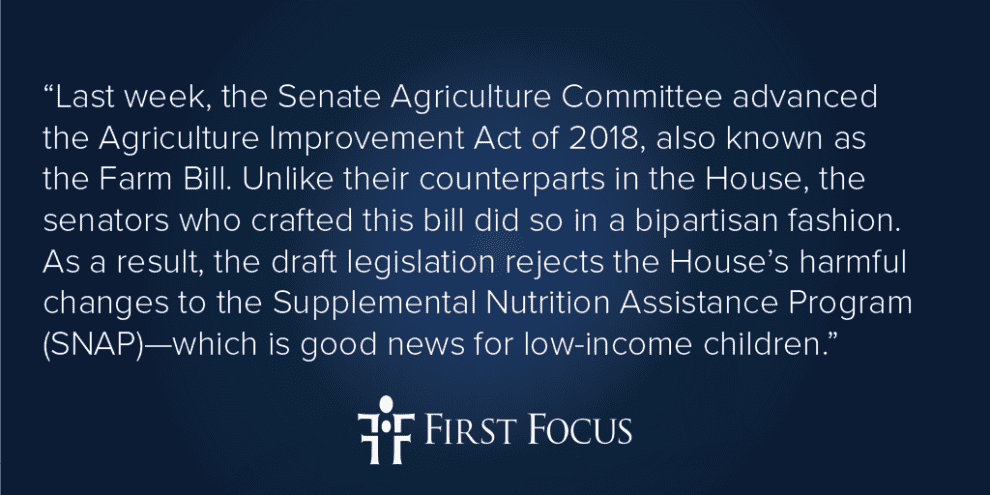
Last week, the Senate Agriculture Committee advanced the Agriculture Improvement Act of 2018, also known as the Farm Bill. Unlike their counterparts in the House, the senators who crafted this bill did so in a bipartisan fashion. As a result, the draft legislation rejects the House’s harmful changes to the Supplemental Nutrition Assistance Program (SNAP)—which is good news for low-income children.
SNAP is the first line of defense against hunger and food insecurity for low-income individuals, especially the 19.2 million children who represent nearly half of all SNAP participants. This Farm Bill acknowledges the critical role that SNAP plays in lifting children out of poverty and keeping food on the table. Specifically, it avoids the House Bill’s many harmful changes that would have resulted in households with children receiving reduced SNAP benefits—if not losing them entirely. It also fully rejects the Administration’s harmful and expensive proposal to fundamentally change the nature of the program by shifting a portion of a family’s benefits to a system of “Harvest Boxes.”
The Senate Farm Bill also invests in the SNAP’s effectiveness by making it easier for seniors—including those who are acting as legal guardians for their grandchildren—to stay on SNAP, and adds additional resources to programs that incentivize SNAP participants to use their benefits to purchase healthy food options such as fresh fruits and vegetables. With this bill, the Senate Agriculture Committee has recognized the fundamental role that food assistance plays in helping struggling families get back on their feet. Preserving the existing structure and scope of SNAP is an investment in the health, education, and future economic success of our nation’s low-income children.
Of course, the Senate Farm Bill does not pursue the types of policy changes that would make SNAP even more effective for children. While SNAP is an incredibly effective program, monthly benefits are often inadequate for families with children, who report exhausting their allotment by the end of the month. Similarly, existing rules that take SNAP benefits away from so-called Able-Bodied Adults Without Dependents (ABAWDs) if they don’t meet work requirements after 3 months can, and do, have spillover effects on children and youth. For instance, youth aging out of foster care experience high rates of unemployment and poverty. Yet this population, as well as unaccompanied homeless youth, faces barriers to accessing SNAP due to existing ABAWD time limits.
These problems have solutions: for instance, Senator Gillibrand has offered legislation—the SNAP for Kids Act (S. 2723)—to increase monthly benefit sizes for families with school-aged children. Representative Lawson last year introduced the College Student Hunger Act (H.R. 3875), which would allow college students to be eligible SNAP if they are in foster care or are classified as an unaccompanied youth who is homeless.
Still, in this polarized political climate, the mere production of a bipartisan bill—even if it does not contain the aspirational policy provisions mentioned above—is a victory, especially when it means families with children won’t have to worry about losing their ability to put food on the table.